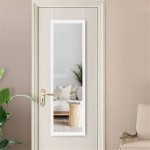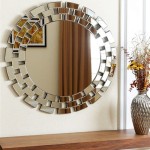Is The Car Window Mirror Concave Or Convex? Understanding Automotive Mirror Design
Automotive mirrors are essential safety components, providing drivers with crucial visibility of their surroundings. The design of these mirrors, particularly the shape of the reflective surface, plays a significant role in the field of view and image characteristics they offer. The question of whether a car window mirror is concave or convex requires a nuanced understanding of different types of mirrors used in vehicles and their specific applications.
The terms "concave" and "convex" describe the curvature of a mirror's reflective surface. A concave mirror, also known as a converging mirror, curves inward, like the inside of a spoon. This type of mirror can magnify images and is often used in applications where a close-up or detailed view is needed. Conversely, a convex mirror, also known as a diverging mirror, curves outward, like the outside of a spoon. This type of mirror provides a wider field of view, though at the expense of image magnification and with the introduction of image distortion.
To definitively answer the question, it's important to distinguish between the different types of mirrors found in a vehicle: the rearview mirror (interior mirror) and the side mirrors (exterior mirrors). While all aim to enhance driver awareness, their requirements differ, leading to variations in design and curvature.
Rearview Mirror: Primarily Planar, With a Twist
The interior rearview mirror is generally designed as a planar (flat) mirror. This type of mirror provides an accurate representation of distance and size, allowing the driver to judge the speed and proximity of vehicles behind them accurately. A flat mirror reflects light at the same angle it is received, resulting in a true-to-life image. However, planar mirrors offer a limited field of view, particularly across the vehicle's width.
Many modern rearview mirrors incorporate a prism or other mechanism to switch between a "day" and "night" setting. This feature reduces glare from headlights at night. The "night" setting typically uses a partially reflective surface, allowing only a fraction of the light to reach the driver's eye, thereby diminishing the intensity of bright headlights. This mechanism does not change the fundamental planarity of the mirror's reflective surface but alters the light path to reduce glare.
While the primary reflecting surface of the rearview mirror is planar, some advanced systems incorporate a slight curvature or aspherical elements to subtly broaden the field of view. However, these are typically minor deviations from a flat surface and are not considered significantly concave or convex.
Furthermore, it's crucial to acknowledge technological advancements that are influencing rearview mirror design. Camera-based rearview mirrors, which display a video feed from a rear-mounted camera, are becoming increasingly prevalent. These systems offer a much wider field of view and the ability to see beyond obstructions within the vehicle. While they are often still referred to as "rearview mirrors," they no longer rely on direct reflection from glass and therefore bypass the issue of concave or convex curvature.
Side Mirrors: Employing Convexity for Enhanced Visibility
Unlike the rearview mirror, side mirrors (both driver-side and passenger-side) are commonly convex. This design choice is deliberate and directly addresses the need for a wider field of view. Convex mirrors compress the image, making objects appear smaller and farther away than they actually are. This trade-off is considered acceptable because it allows the driver to see a larger area around the vehicle, particularly in the blind spots. The enhanced visibility significantly improves safety during lane changes and maneuvers in traffic.
The degree of convexity in side mirrors is often regulated by safety standards. These regulations aim to strike a balance between providing a sufficiently wide field of view and minimizing distortion to the point where it compromises the driver's ability to judge distance accurately. The specific requirements vary by region and vehicle type but consistently prioritize the ability to detect and avoid potential hazards in adjacent lanes.
The inherent distortion of convex mirrors is typically addressed through driver education and visual cues. Many vehicles include warnings on the side mirrors, such as "Objects in mirror are closer than they appear," serving as a constant reminder of the inherent limitation of this type of mirror. Drivers learn to compensate for the distortion through experience and by combining information from the side mirrors with glances over their shoulders.
Advanced driver-assistance systems (ADAS) are further mitigating the limitations of convex mirrors. Blind-spot monitoring systems use sensors to detect vehicles in the driver's blind spots and provide alerts, either visual or auditory, to warn the driver before initiating a lane change. These systems act as a supplement to the information provided by the side mirrors, enhancing overall safety and reducing reliance on distance estimation based solely on the distorted image.
Addressing Aspherical Mirrors and Complex Designs
Beyond simple planar and convex designs, some automotive mirrors incorporate aspherical surfaces. An aspherical mirror has a curvature that varies across its surface, allowing for a more complex and optimized field of view. These mirrors may combine areas of different convexity, providing a wide-angle view in some sections while maintaining a more accurate representation of distance in others.
Aspherical mirrors are often used in side mirrors to further reduce blind spots. The outer portion of the mirror, farthest from the driver, may have a greater degree of convexity to capture a wider field of view, while the inner portion, closer to the driver, may have a more gradual curvature to provide a less distorted image of nearby objects. This combination of curvatures provides a more comprehensive view of the surroundings without sacrificing the driver's ability to judge distances effectively.
Manufacturing aspherical mirrors is more complex and costly than producing simple planar or convex mirrors. The precise curvature must be carefully controlled to ensure that the mirror provides the intended field of view and minimizes distortion. However, the benefits in terms of enhanced driver visibility and safety often outweigh the increased manufacturing costs, particularly in high-end vehicles.
The integration of cameras and sensors into modern vehicles is also influencing the design of aspherical mirrors. Some manufacturers are using aspherical mirrors in conjunction with camera-based systems to provide a seamless and comprehensive view of the vehicle's surroundings. The mirrors provide a basic level of visibility, while the cameras and sensors provide additional information and warnings about potential hazards. This integrated approach is leading to even safer and more intuitive driving experiences.
In conclusion, the answer to whether a car window mirror is concave or convex is not straightforward. The rearview mirror is typically planar, while the side mirrors are commonly convex. Some advanced designs utilize aspherical surfaces to optimize the field of view and minimize distortion. The specific design of each mirror is carefully considered to meet safety regulations and provide drivers with the best possible visibility of their surroundings.

Convex And Concave Mirrors In Cars

Concave Vs Convex Mirrors In Cars
In Trucks Cars Buses Side View Mirrors Are Convex But Center Rear Mirror Is Or Plane Quora

Convex Mirrors Use Car

Concave Vs Convex Mirrors In Cars

Concave Vs Convex Mirrors In Cars

Concave Vs Convex Mirrors In Cars
Solved 3 In Fig 2 If We Increase The Index N But Keep Chegg Com

Convex Concave Mirror Car Motorcycle Rear View Glass China Silver Made In Com

What Is The Difference Between Convex And Concave Mirrors Digest








